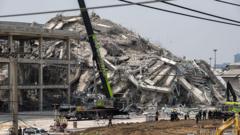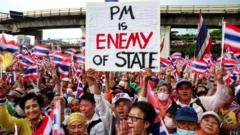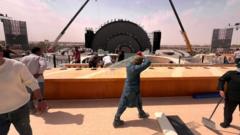At least 89 confirmed dead and ongoing investigations suggest structural flaws may have contributed to the collapse.
**Seventeen Arrest Warrants Issued Following Bangkok Skyscraper Collapse**

**Seventeen Arrest Warrants Issued Following Bangkok Skyscraper Collapse**
Authorities target individuals linked to the disastrous construction of a 30-storey tower that fell during a recent earthquake.
In a significant development following the tragic collapse of a skyscraper in Bangkok, Thai authorities have issued 17 arrest warrants for individuals associated with the construction of the 30-storey tower. This structure, intended to house the State Audit Office, crumbled during a powerful 7.7 magnitude earthquake that struck Myanmar in March.
Rescue teams have reported recovering 89 bodies from the debris, although seven individuals remain unaccounted for. The arrested individuals include architects, builders, and construction supervisors, with businessman Premchai Karnasuta, a former president of the prominent Italian-Thai Development PLC, notably identified by police. Reports suggest investigators uncovered serious structural flaws, particularly within the lift shaft of the tower.
Despite the earthquake's intensity, most other buildings in Bangkok withstood the tremors. However, the ill-fated State Audit Office, characterized by its distinctive blue glass and steel design, suffered catastrophic damage. Built at a cost exceeding 2 billion Thai baht (around $59 million), the tower had been under construction for three years.
On the day of the collapse, over 400 workers were present on-site, prompting the deployment of drones, sniffer dogs, cranes, and excavators for the ensuing rescue operation. The earthquake that struck Myanmar on March 28 resulted in over 3,000 fatalities and more than 4,500 injuries, with its tremors felt across neighboring regions, including Thailand and parts of southwest China.
As investigations continue into the causes of the disaster, shockwaves from the incident raise questions about construction regulations and safety practices in the region.
Rescue teams have reported recovering 89 bodies from the debris, although seven individuals remain unaccounted for. The arrested individuals include architects, builders, and construction supervisors, with businessman Premchai Karnasuta, a former president of the prominent Italian-Thai Development PLC, notably identified by police. Reports suggest investigators uncovered serious structural flaws, particularly within the lift shaft of the tower.
Despite the earthquake's intensity, most other buildings in Bangkok withstood the tremors. However, the ill-fated State Audit Office, characterized by its distinctive blue glass and steel design, suffered catastrophic damage. Built at a cost exceeding 2 billion Thai baht (around $59 million), the tower had been under construction for three years.
On the day of the collapse, over 400 workers were present on-site, prompting the deployment of drones, sniffer dogs, cranes, and excavators for the ensuing rescue operation. The earthquake that struck Myanmar on March 28 resulted in over 3,000 fatalities and more than 4,500 injuries, with its tremors felt across neighboring regions, including Thailand and parts of southwest China.
As investigations continue into the causes of the disaster, shockwaves from the incident raise questions about construction regulations and safety practices in the region.



















